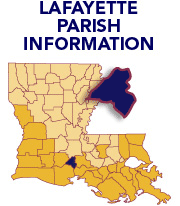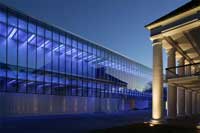 |
| |

Click on a parish to change parishes. |
| |
|
| |
|
| |
|
| |
|
| |
|
| |
PARISH PLANNING BASELINE |
|
|
|
|
| |
|
| |
| |
| |
|
| |
|
| |
 |
|
|
 |
|
Lafayette Parish
Lafayette Parish, in the heart of Acadiana, is known for its unique cuisine, Cajun and Creole cultures, music, and outstanding hospitality. Early in Lafayette's history, a rich French heritage blended with Spanish, American Indian and African influences to create the extraordinary mixture of tradition and progressiveness evident today. Currently home to approximately 200,000 residents, the parish has a diversified economy. Important sectors include the oil & gas industry, agriculture/aquaculture, mining, leisure & tourism, manufacturing, and technology resources.
A top priority among parish leaders is the ability to provide quality services and a high quality of life to all Lafayette residents. While Lafayette Parish was fortunate in not experiencing a direct hit from either storm, critical needs were exposed as a result of each. In particular, the estimated 8.25% increase in population since August 2005, or roughly 15 years of projected population growth, has overloaded existing infrastructure. In addition to daily traffic congestion, these storms have amplified the need for more adequate and efficient evacuation routes to service Lafayette Parish and those southerly Parishes that must travel through Lafayette to evacuate. Further, parish officials are focusing on providing quality housing and community development options as a key component for the recovery of the entire state. |
|

 |
| As of the 2000 census, Lafayette Parish had a population of 190,503.
The parish has a total area of 700 km2 (270 mi2). 699 km2 (270 mi2) of it is land and 1 km2 (0 mi2) of it is water. The total area is 0.17% water.
The parish seat is the City of Lafayette.
The city was founded as Vermilionville in 1821 by a French-speaking Acadian named Jean Mouton. It was later renamed for the Marquis de Lafayette, who assisted the United States during its Revolutionary War.
The city's economy was primarily based on agriculture until the 1940s, when the petroleum and natural gas industry became dominant.
Lafayette is approximately 90% Roman Catholic and thus, has an evenly large ratio of Catholic schools.
In the 1970's, the City of Lafayette had the distinction of having more millionaires per capita than any other city in the United States. |
|
|








